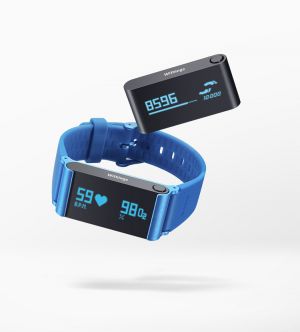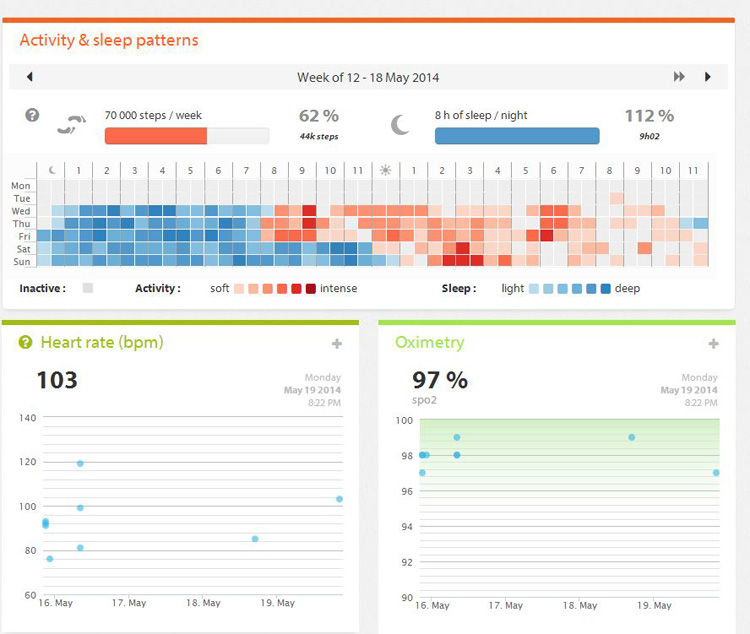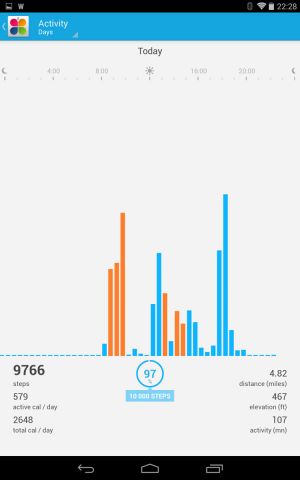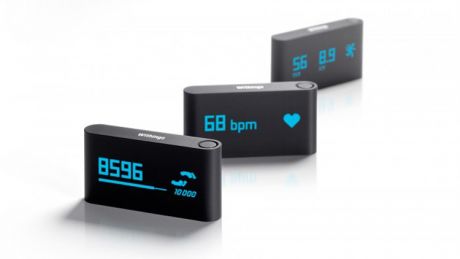You can trust Coach
The Withings Pulse O2 is an activity tracker for people looking to become more active, rather than those who already have a strict fitness regimen. At £99, it’s a little more expensive than the Fitbit Flex, but for that extra cash you get a display and a built-in device to measure pulse and blood oxygen (SpO2).
Blood oxygen is measured as a percentage, and the Pulse O2 tells you how much oxygen is being absorbed into your bloodstream and, therefore, how much is making it to your muscles. However, realistically, knowing your blood oxygen levels won’t affect your fitness routine, and Withings says that it’s only when levels get below 90% that you should consult a medical professional. Symptoms of low blood oxygen levels – known as hypoxemia – include sleeping problems and breathlessness, which suggests to us that you would know something was wrong if you suffered from it. The SpO2 function of the device is therefore only really an indication of health, rather than a useful fitness aid.
Design and battery
The Pulse O2 has the same design as Withings’s original Pulse device – a small, black, rounded oblong with a 128x32-pixel LED display. The device comes with a wrist strap and a silicone housing with a clip. We much prefer the clip to the cheap-looking, light blue rubber strap because it allows us to keep the device out of sight while going about our daily routine.

A single button flips through the various figures the Pulse O2 tracks: steps taken (walking and running), distance travelled, altitude climbed, calories burned, the time of day and your device’s battery indicator. There’s also a screen which gives you the option to take a pulse and SpO2 measurement or tell the device you’re going to sleep, at which point it will start monitoring your night-time behaviour. You can also swipe left and right on the touch-enabled screen to look at your activity on previous days.
Internal components include a three-axis accelerometer, an LED-powered optoelectronics sensor for pulse and SpO2, as well as a low-power Bluetooth 4.0 transmitter/receiver.
The display, which is made up of blue LEDs, is bright enough for indoor conditions, but as soon as it’s hit by sunlight or viewed from even a slight angle, its readability rapidly deteriorates to the point where it’s completely illegible.
The payoff of the compromised viewing experience is fantastic battery life. Withings claims up to two weeks of activity monitoring, and we didn’t need to begin charging our device until well into our second week of using it. When the juice does run low, you can simply connect it to any microUSB charger for a few hours.
Sign up for workout ideas, training advice, reviews of the latest gear and more.
Fitness focus
The Pulse O2 can only track walking and running, so those who cycle or exercise in any other way will need additional apps or gadgets to keep a full record of their activity.
The key to the Pulse O2 is its simplicity. It’s constantly measuring steps taken and should always detect how intense your activity is. The device can understand ‘soft’, ‘moderate’ and ‘intense’ exercise, although when we went for a run it only registered it as ‘moderate’ activity, which is the same classification for our brisk walking pace.

The built-in altimeter also tracks how far you’ve climbed, which is as useful for hikers as it is for people who just want to take the stairs a little more often.
The process of measuring your pulse and SpO2 is rather fiddly and it’s unlikely you’ll be able to do it while on the move. You’ll need to remove the device from the wrist strap or the clip in order to access the sensor, scroll through five menus and then tap on the onscreen heart icon.
At this point, the device will take around 15 seconds to take its measurements, but it’s a hit-and-miss process. All too often the device would return absurd results, such as a resting heart rate of 112bpm, and would sometimes fail to measure anything at all. It’s not a great performance from a device which takes half of its name from the heart rate monitor.
Like many activity trackers and mobile phone apps before it, the Pulse O2 also tracks your sleeping behaviour. Simply tell the device you’re in bed, and it will begin measuring your movements, estimating how much deep sleep and light sleep you’ve had during the night. The only information the watch shows you is the time you’ve been asleep – you’ll need the companion mobile app or the web interface to make sense of it. It did appear to rather underestimate the time it took us to get to sleep, and on most occasions it assumed we were out for the count after around ten minutes, which was not the case.
Staying mobile
When the Pulse O2 is first switched on, you’ll be prompted to create a Withings account and pair the device with a smartphone or tablet via Bluetooth. This is done using the Withings Health Mate app, available both on Android and Apple iOS devices.
Once the data is loaded into the app, Withings Health Mate presents your activity in the form of graphs and charts, and also provides tips, notifications and targets to reach. It’s fairly simple stuff, and we found the desktop web interface much more intuitive and useful than the simplistic mobile app.

The Android app doesn’t currently keep track of your SpO2 levels, which is a shame as both the iOS and web interface do. It also doesn’t differentiate between a resting pulse measurement and a measurement taken after exercise, so if you’ve recorded a high pulse rate it will warn you that it’s an unhealthy figure, even if it had been taken just after or during a workout.
The one advantage of using the mobile app is that it hooks into third-party fitness apps such as RunKeeper as well as other Withings products, importing that data to effectively turn the Withings app into your mobile health headquarters.
Verdict
The Withings Pulse O2 is a good introduction into the world of activity tracking for a price that will be attractive to many. It keeps out of the way, quietly tracking your every move. It’s unfortunate that the heart rate sensor is unreliable, as this should be one of the biggest selling points it has over some other cheap devices.
If you’re just looking to be a little more active, you should also consider the Fitbit One because, while it has fewer bells and whistles, it does pretty much the same job for a little less money.
If you’re serious about your fitness, you’d be better off spending more money on the Garmin Vivofit or a Nike FuelBand, both of which have a more hands-on experience as well as better mobile apps.
6/10

